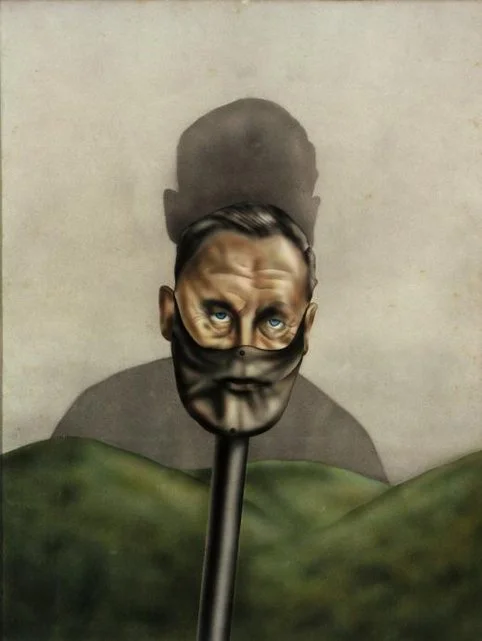Dark Arts
21 October 2011 - 15 January 2012
Long Gallery
From the shadows of the Collection, Dark Arts shows works that are linked thematically by their reference to the darker subjects of death, fear and violence.
Please note that some images may disturb younger viewers and discretion is advised.
Many of the works in Dark Arts use their subjects' faces to communicate feelings of vulnerability and express dark emotions.
John Lethbridge's Masked Face (Water colour and paper collage) shows a mask on a pole, like a sort of signpost in a McCahon-esque landscape. The lower part of the mask seems to be made of another material, perhaps iron, and riveted to a more realistic model. With the mouth covered by this addition, it gives the impression of the subject being silenced or smothered.
Brit Bunkley's Body Snatcher Portraits #5 and #6 (2003), covered with a seemingly benign pattern of coloured flowers, give an uneasy sense that the subject has been taken over by some outside force in (as the title suggests) a deliberate and malicious act.
In both Link Choi's Christ at the Pillar (2009), and Trevor Fry's My Magritte Lovers Indecision (Withdrawal) (1988), the subjects are naked with their heads covered. Both in interior spaces, they give a sense of vulnerability which may prompt the viewer to ponder their fate. Whilst Fry's subject is incriminated in a sexual context by the title of the work, we cannot place his role in the narrative, is he an aggressor or victim? Are his hands tied behind his back or is this position one of nonchalance? The reference to surrealist Rene Magritte leads to further doubt about the reality of the scene.
The face of Sam Harrison’s Crawling Man (2010) is not visible when the viewer is observing from above the sculpture. The position of the figure is one of desperation; his white wax-cast body may remind the viewer of the fossilized remains of residents of the Italian city of Pompeii, suspended in their escape tracks when Mount Vesuvius erupted. Opposite this work Lois White’s Hiroshima (1964) echoes the same theme of tragedy. The faces of the subjects here are clearly visible, filled with expressions of pain and anguish.
The human skull is a motif present in several works. Wax to Wax on Wax. For James My Champion xxxx (2007) is a screen print on silver foil by Max Gimblett. Gimblett's typical quatrefoil design fades into a luminous background of silver foil as a grinning skull extends towards the viewer. The same skull is seen, central again in Tony Fomison's Memento Mori (1979). Memento Mori is Latin for "remember death", a phrase meant to remind us of our mortality. Lee Brogan's Bombora (2008) reminds us also of the fragility of life, through the medium of pate de verre glass. The skull in this work is delicate, fading from crystalline white to an inaudible grey and disintegrating at the edges. It may question where the line between life and death is located and reminds us of the ephemeral nature of our bodies.



